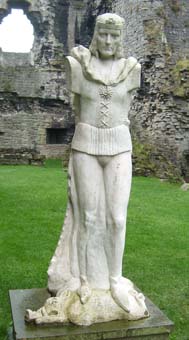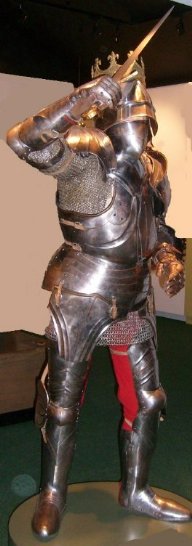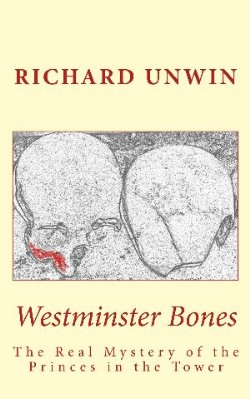When dealing
with the subject of King Richard III and what happened to the Princes in the Tower of London, the sons of Edward
IV, the uncrowned and bastardised Edward V and Richard duke of York,
there seems to be just two schools of thought: that Richard III
murdered them, or that someone else did.
This latter option is divided between Henry Tudor, the seventh of
England, and Henry Stafford, duke of Buckingham. There is, however, another opinion:
that one of the princes died a
natural death while the other escaped to a place of safety. The
suggestion of death by natural causes may not have the dramatic ring that
murder does, but of all the possibilities that might emerge from what we know
of the events of 1483, this one at least is as reasonable, if not more so, than
many other hypotheses.
Conventional
stories of Richard III and the Princes in the Tower of London describe an abiding
mystery. There is, so far as historical
research can discover, no certain answer. On the face of it, this may be
thought to have been the case at the time
also. It seems that nobody then could
get to the bottom of what had actually happened to the two princes either. Learned books that are based only on
scholarly historical research are handicapped, to some extent, by the
expression of ideas that can only be proved or often demonstrated likely as
being true by reference to an actual record of some kind. As soon as speculation enters the work, then
inevitably some credence is lost; yet often, reasoned speculation is the only
way forward otherwise the whole work might become inchoate and flounder. Some writers succumb to temptation and take
sides. The risk here is the possibility
of misinterpretation of facts, especially where a historical circumstance seems
at odds with the thrust of an argument and thus hypothesis is massaged to
suit. We all of us form an opinion as
to what we consider to be the likeliest run of events, especially when we have
read extensively on the subject, but there are often grey areas that, were we
in possession of the true facts as to what actually happened, might alter our
hitherto certain perceptions absolutely.
The story of Richard III, and the aftermath of his reign, certainly has more than
enough high drama to sustain a good tale. When reading up on the subject we are struck by many ambiguities that
cloud the events, ambiguities that must be overcome to progress our
understanding of the story. The first
one is the apparent change of Richard’s character from one who is completely
and consistently loyal to his brother, Edward IV, to one who coverts the crown
even to the extent of murdering his brother’s sons. Second only to this is the attitude of Elizabeth Woodville,
Edward’s queen and mother to the princes supposedly murdered by Richard, who
had bastardised them and proclaimed himself king. Though she makes a great public show of anguish and grief at what
she allows people to think of as the murder of the princes, yet she encourages
her daughter, Elizabeth of York, to set her cap at Richard when it is realised
his wife is dying.Then, after the
Battle of Bosworth, we find the victorious Henry Tudor, now king of England,
beset at intervals by two “pretenders” to his throne, one claiming to be Edward
earl of Warwick, the son and heir of George duke of Clarence, and the other the
younger of the two princes, Richard duke of York. The first is Lambert Simnel and the second is Perkin
Warbeck.
The point here is that, though nobody at the time seems to have had any difficulty
in believing Prince Edward was dead, there is doubt regarding the demise of
Prince Richard. Was this due to
“underground” knowledge? Moreover, if
Prince Edward had died a natural death and his brother removed to a safe place,
then this would account for Elizabeth Woodville’s and her daughter’s attitude
to Richard III. Their grief for
Edward’s natural death would be real, but they knew Richard III had not
murdered either of the boys. Perhaps
they remained silent due to the machinations of the Tudor faction, and they
naturally would want to keep secret the idea that the younger boy was free. If they
knew what really happened then it is a fair bet that there were others who knew
as well.
This would account for the readiness of the some in the aristocracy, after the
Battle of Bosworth where Richard III was killed, to promote first Lambert
Simnel and then, later, Perkin Warbeck. Whether or not they believed that these were who they said they were is
uncertain. Lambert Simnel certainly was an impostor and some have postulated
that he was merely there to pave the way for the real prince, Richard of York
who would return once Henry VII had been removed. The readiness of many of the
nobility to support them, both in England and on the continent, suggests they
believed that the real Prince Richard was out there somewhere, and so it seems
did Henry Tudor and for that matter his son, Henry VIII. One hundred and ten years or so later,
towards the end of the reign of Elizabeth I, William Shakespeare would
deliberately portray Richard III in a monstrous caricature, indicating that
even at this remove in time, Elizabeth Tudor still felt threatened by the
possibility that Plantagenet ancestors might still be around. Moreover, his sponsor in 1593 when the play
was first produced was Ferdinando Stanley, Lord Strange, heir to Henry Stanley
fourth earl of Derby. His ancestor was one who betrayed Richard III and helped
Henry Tudor to the throne, yet Shakespeare, careful and pragmatic, would so
over-blow his characterisation that he seems to be asking us “can you really believe
this”? Perhaps he knew something too.
It is suspected, though by no means certain, that Prince Edward had a disease of
the jaw when he entered the Tower. Apart from the fact that he felt himself to be deprived of his kingship,
he was certainly ill with a malady of some sort, as evidenced by the presence
of a physician in the Tower, Dr. John Argentine; therefore he would not be much
of a companion for his younger brother. We cannot be sure that the other prince was actually Richard of York
and perhaps a substitute for him was introduced, both to secure the safety of
the real prince and to provide companionship for the sick Edward. Another
possibility is that the younger of the Princes in the Tower was smuggled out after his elder
brother’s death, thus neither of the princes were in the tower, which is why
king Richard III could not produce them when rumour of their deaths began to
circulate.
The story of their murder began as Lancastrian propaganda. With the threat of Henry
Tudor, a man of dubious lineage bidding for the throne, the continued existence
of a Plantagenet prince would be a possible future trump card. Henry Tudor
planned to marry one of the daughters of Edward IV to establish some royal
blood in the veins of his heirs; (he eventually did so marrying Elizabeth of
York, eldest daughter of king Edward IV). To do this he would have to
re-legitimise them and this meant re-legitimising their brothers, too. In this
case, the Princes in the Tower would once again become the rightful heirs to the throne of
England, confounding Henry’s own ambition. For his plan to work the princes had
to die, but he needed to get hold of them first. Edward’s death from natural
causes made his task easier, there afterwards being just one living prince.
This is why prince Richard of York had to be taken away to safety where he
would be a perpetual threat to the Tudors.
If Elizabeth Woodville conspired in this, and the knowledge spread around a few in
the aristocracy, it is entirely possible that others would find out too and
this could account for Henry Tudor’s nervousness and the attitudes of those who
came to promote the “pretenders”. Even when questioned later by her son-in-law,
Henry Tudor, Elizabeth Woodville refused to
admit that her sons were dead or even that they were missing. To ensure her
silence she was confined to a nunnery for the rest of her life, cut off from
the world.
This accounts for why nobody questioned that prince Edward was dead, after all, the
rumours that were spread by the Tudors was that both princes were murdered, so where did the idea come from that
one of them escaped and that he was Richard of York? After all, when engaging
in a conspiracy, wouldn’t an escaped king’s first heir be a better bet, unless
it was certain he was dead? One thing is sure, the attitude of Henry VII and
his heirs indicate doubt, in spite of their propaganda to the contrary. It
remains a strong possibility that there was no murder, unless, of course, we
count the eventual contrived trials and executions of Perkin Warbeck and Edward
of Warwick; but that is another story.
The story of King Richard is told in On Summer Seas, and continued in A Wilderness of Sea,
which tells of the possible fate of the Princes in the Tower. Go the the home page for
links to the book shop.
Home Page




